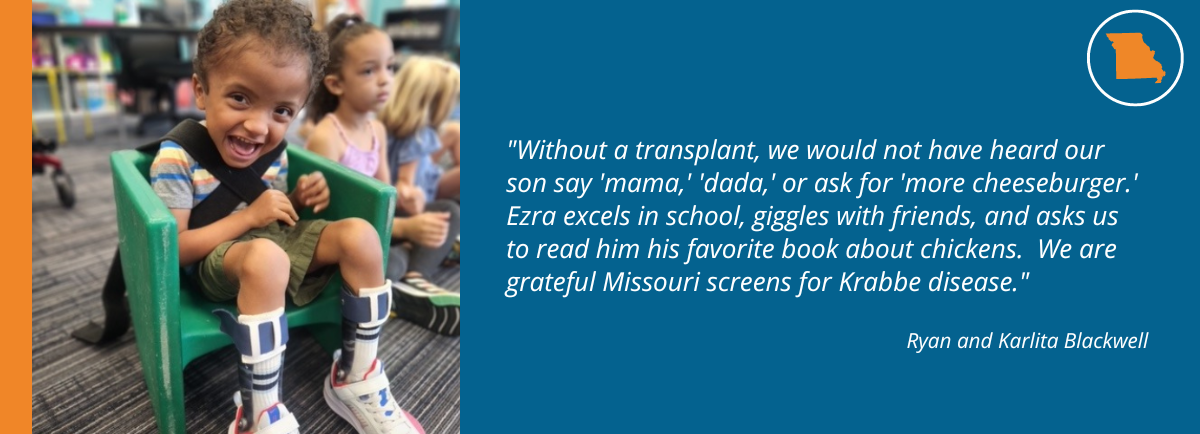DOWNLOAD STATE FACT SHEET AS PDF

In 2020, there were 69,285 live births in Missouri2 There are 77 conditions on the Missouri Newborn Screening Panel3
All babies born in the United States are screened for several conditions shortly after birth. Approximately 24-48 hours after a baby is born in the United States, a nurse pricks the heel to collect a small blood sample. Afterward, the nurse puts a series of blood drops onto a filter paper to create several “dried blood spots.” Next, the newborn screening card is sent to the state laboratory for analysis. Missouri is 1 of 11 states currently testing for Krabbe disease. Missouri started screening for the disease in 2012.
What is Krabbe Disease?
Krabbe disease (pronounced krab A), is a rare genetic disorder, also known as globoid cell leukodystrophy. In the United States, Krabbe disease has been reported to affect approximately 1 in 100,000 individuals. Infantile Krabbe disease is the most common and severe form causing infants to lose the ability to eat, extreme irritability, inability to sit up, grasp objects, blindness, and seizures. Sadly, infants die within the first 2-3 years of life in states that do not test for Krabbe disease. We invite you to learn more about Understanding Krabbe Disease.
Why Screen for Krabbe Disease?
Krabbe disease is a severe neurodegenerative and rapidly progressing condition requiring immediate treatment for the most severe forms. The medical issues and symptoms of Krabbe disease are very significant and life-impacting. A delayed diagnosis, especially in the most severe forms, equates to palliative and supportive care as the only means of treatment until premature death.
Krabbe Disease Hero: Ezra Blackwell

See all our Krabbe Disease Heroes.
Ezra was born to parents Ryan and Karlita in October 2016. As they were adjusting to life with a newborn, they received a phone call that would change everything: Ezra had Krabbe disease. It had been identified through Newborn Screening. The call was very difficult because the genetic counselor had no knowledge of Krabbe disease and had no direction to point them toward. It was a traumatic experience.
While overcome with shock and devastation, Ryan and Karlita were given a glimpse of hope when they were connected with Dr. Joanne Kurtzberg at Duke University that same evening; she informed them of Ezra’s eligibility for treatment – a stem-cell transplant – because he had been diagnosed early. The same evening of his diagnosis, they made the decision to travel to Duke for his life-saving transplant.
Ezra remained at Duke University for the first six months of his life during his transplant and recovery process. Although he experienced some side effects from chemotherapy, he thankfully had no major complications. Three of these months were spent living in the hospital and the remaining three months were spent as an outpatient. After returning home, they weren’t sure what their lives would look like but knew that Ezra was a fighter. Since then, he has proven that fact time and time again.
Today, Ezra loves horseback riding, going to the beach, swimming, playing games, riding his adaptive bike, playing with friends, and his dog, Coco. He loves attending school and his joy is contagious. He would eat donuts and bacon for every meal if his parents would allow it. Ezra is thriving.
Resources
- The Leukodystrophy Newborn Screening Action Network is dedicated to advancing newborn screening for leukodystrophies and lysosomal storage disorders, supporting newly-diagnosed families, and ensuring collaboration between all stakeholders. Learn more at https://ldnbs.org/.
- CDC offers funding and assistance through the Newborn Screening Quality Assurance Program (NSQAP). More information can be found at https://www.cdc.gov/labstandards/nsqap.html.
- Baby’s First Test provides funding opportunities through grants. Learn more at https://www.babysfirsttest.org/newborn-screening/funding-opportunities.
- American Public Health Laboratories NewSTEPS program provides data, technical assistance, and training. Details at https://www.newsteps.org/.
- KrabbeConnect offers patient support services to help families navigate the burden of Krabbe disease. Learn more at https://krabbeconnect.org/.
- Hunter’s Hope Foundation is a non-profit organization committed to giving hope through education, awareness, research, and family care for all leukodystrophies. Learn more at https://www.huntershope.org/ .
Citations
- Wenger DA. Krabbe Disease. 2000 Jun 19 [Updated 2011 Mar 31]. In: Pagon RA, Adam MP, Ardinger HH, et al., editors. GeneReviews® [Internet]. Seattle (WA): University of Washington, Seattle; 1993-2017.
- “Fertility Rate: Missouri, 2010-2020.” March of Dimes | PeriStats, https://www.marchofdimes.org/peristats/data?reg=29&top=2&stop=10&slev=4&obj=3&sreg=29. Accessed 31 July 2023.
- “Missouri| Baby’s First Test | Newborn Screening | Baby Health.” Babysfirsttest.org, 2015, https://www.babysfirsttest.org/newborn-screening/states/missouri. Accessed 31 July 2023.
All information in this fact sheet is based on data available before July 31, 2023.


